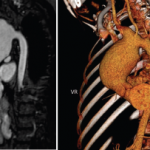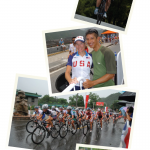
After my editorials on coaching, I was going to give sports a rest and move on to more weighty topics worthy of a medical magazine. The inspiration well was also dry. The European Cup was over. Tiger was out for the season. The sports section was dreary, as rap sheets and tox screens crowded away the box scores.
On the verge of describing a diagnostic dilemma I encountered in clinic (trust me, a real puzzler), I saw a sports story I could not resist. As the news media reported endlessly and breathlessly, Sanya Richards, winner of the U.S. Olympic trials in the 400-meter dash, has Behçet’s disease, a serious and rare affliction which nevertheless did not prevent a rousing victory.
As a human interest story, the account of Richards has the requisite stuff: a dire diagnosis, triumph over adversity, and a saga of personal courage. This combo is a journalistic trifecta to keep any sports fan transfixed in front of the TV as Richards’ exploits enfold.
Because Behçet’s is in rheumatology’s bailiwick, I was happy to have the media’s spotlight shine on one of our diseases, according it its fifteen minutes of fame. Furthermore, since therapy had seemingly restored Richards to world-class health, I could think of no better recommendation of our specialty’s skill than the sight of Richards beaming on the winner’s stand.
Interest (and Press) for Rheumatology
While I thought that this was nifty story, I had a sense of discomfort for, you see, I have heard it before. Consider for a moment, the following athletes and their diseases. Wilma Rudolph, the winner of the three gold medals in the 1960 Olympics, had both polio and scarlet fever as a child. Her bio says that she wore heavy metal braces and that her mother massaged her legs to stimulate recovery.
Another heroine with immune system problems is Gail Devers, the only woman to win consecutive Olympic 100-meter dashes. Devers had Graves’ disease with muscle involvement so severe that her doctors were planning to amputate her feet. Finally, there is Michelle Akers. Once named soccer player of the century, Akers suffered from the debilitating effects of chronic fatigue syndrome, a possible complication of mononucleosis, that left her so exhausted and depleted she needed intravenous fluids to finish her matches.
Given the way athletes beat up their bodies, I expect them to have more than their share of musculoskeletal problems—popped tendons, shredded ligaments, and cracked bones. The immune problems of the athletes, however, are remarkable in their variety and severity.
Behçet’s is a disease of flares and, as sportscasters recounted, during the national championships of 2007, Richards’ condition was flaring away with nasty mouth sores and bronchial irritation. For that competition, Richards ran three 400-meter heats in a three-day period. While medication had reduced her symptoms, she struggled in the finals and her time in the event plunged.
For those of you who have never run the 400-meter, don’t. It is a virtual sprint and you are near anaerobic the whole time. Your blood boils with lactic acid. That stuff is nasty and, when you finish, you want to throw up. I cannot imagine what it feels like to breathe 40 times a minute through a mouth blistering with sores.
Clinical Questions Abound
As a physician, I am intrigued by the accounts of the athletes’ illnesses and how they relate to the care of patients. (At long last, we are onto something relevant. It may take a while, but we usually get there.) Either the doctors caring for these athletes were terrible or they were terrific. For example, as Gail Devers testified to Congress, her physicians missed her thyroid problems for two years, chalking up symptoms of weakness, rapid heart rate, and severe weight loss to the changes expected of an Olympian in training.
A weight loss of 30 pounds? Seems too much to me. A heart rate of 140? All right for the finish of a race, but in the calm of the doctor’s office, that’s on the high side. Hello, but even a medical student knows that resting tachycardia merits a tube of blood for thyroid functions. What about the amputations? As an internist, I would try propylthiouracil first.
Nevertheless, despite a slow and bumpy path to diagnosis, the doctors eventually got it right. They tuned Devers’ thyroid-stimulating hormone perfectly so that she could vanquish the field in the finals and relish her gold. That’s slick doctoring to me. I give those physicians an “A” for quality and would throw in some bonus pay for performance.
Track is very simple. The fastest person wins and, in the sprints, victory is measured in hundredths of a second. In real life, these athletes are fiercely competitive, driven, and self-centered. Some are downright mean, enjoying the competition’s stumbles and flame-outs.
To make for better TV, public relations specialists and press agents are needed to spruce up the athletes, and it seems that the simplest way is to give them a dying relative or dread disease. What better way to enlarge and soften a persona than a story of a phoenix-like ascent from the ranks of the invalid and infirm to the peaks of Olympic glory?
Do Tales of Athletic Miracles Help or Hinder?
The sports pages are filled with cynicism and doubt and it is easy to look with suspicion at athletes, especially those who rake in millions of dollars. These stories, however, have a very serious side because they affect the public perception of disease. If through medication, prayer, or sheer grit, an athlete can overcome Graves’ disease or Behçet’s, what does it say about the diseases’ severity? Are these stories of triumphant recovery enlightening or are they misleading about the totality in which immune disorders can be overcome?
Reading about the Deverses and Richardses of the world I also wonder how patients feel about the chronicles of athletes who share their condition. No doubt, some will rejoice in the success and gain inspiration as they hope for their own improvement. I am sure, however, that patients who have not done well may feel confused, despondent, or even angry, questioning why the medical system has failed them.
I live in North Carolina, which is far from the silk traders’ route. I do not expect to see any patients with Behçet’s soon, but I wonder how I would react if one, press clipping in hand, asked me why I wasn’t able to calm down his mouth sores while Richards’ had vanished. If a reporter asked me about Richards’ case, what would I say?
I suspect that much of what I learn about the lives of athletes is not true. Athletes are people, after all, and they may dissemble, embellish, or even deceive to get to center stage. However, we like to have sports heroes with whom we can connect, and so biographies may need tinkering. To balance out a Marion Jones, who shoots up with steroids on the sly, we may need a Sanya Richards, who takes thalidomide, azathioprine, or whatever else in full view.
It is time to stop philosophizing and start enjoying the Olympics. I will try to believe that, after a serious bout of Behçet’s, Richards could really do 1,500 abdominal crunches a day and vie to be the fastest woman in the world. In August, I will certainly turn on the TV to see what someone with Behçet’s could accomplish, especially in the sooty and polluted air of Beijing.
So, to Sanya Richards, all I can say as I’m writing this is that I am rooting for you in your quest. Stay healthy and take your medications, and I hope that you bring home the gold.
Editor’s Note: Richards won the gold medal for the women’s 400-meter relay and the bronze for the 400-meter.
Dr. Pisetsky is physician editor of The Rheumatologist and professor of medicine and immunology at Duke University Medical Center in Durham, N.C.



